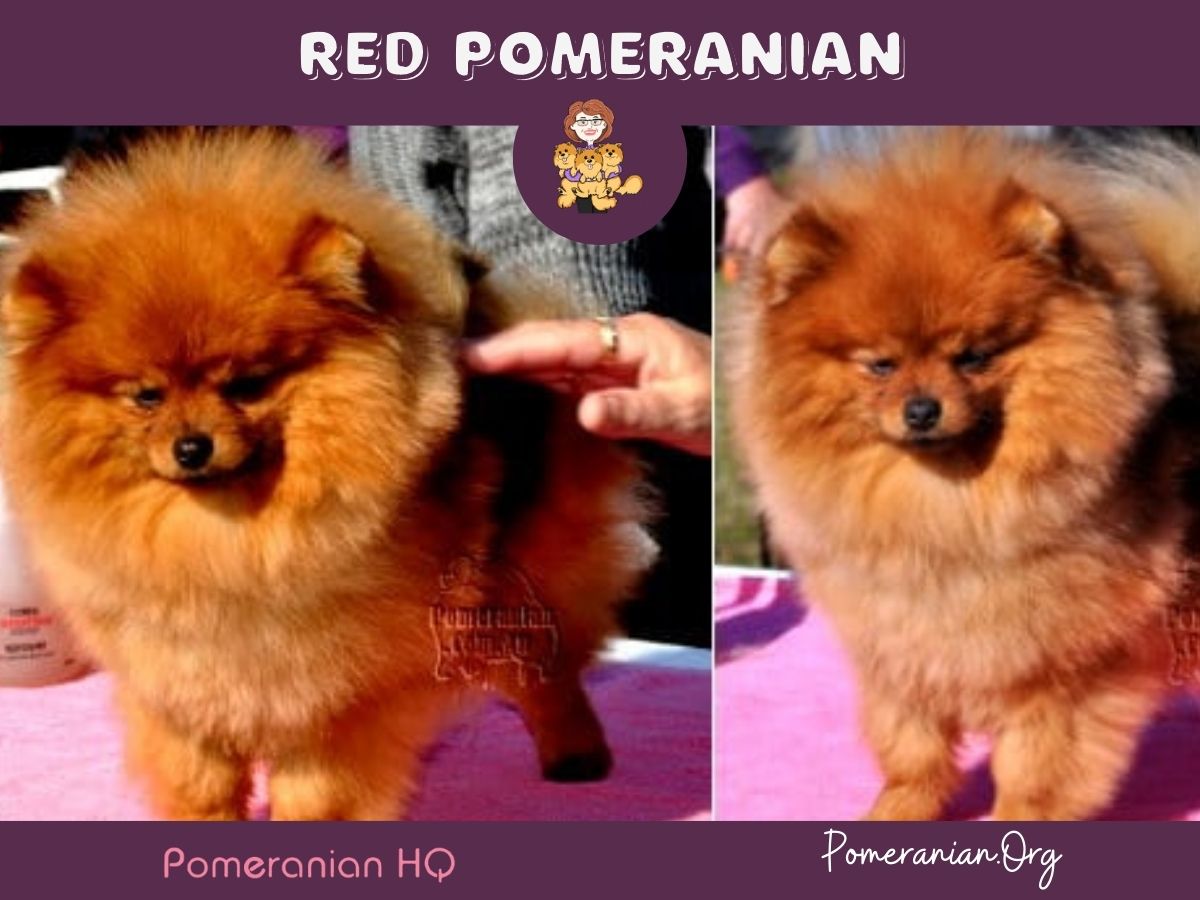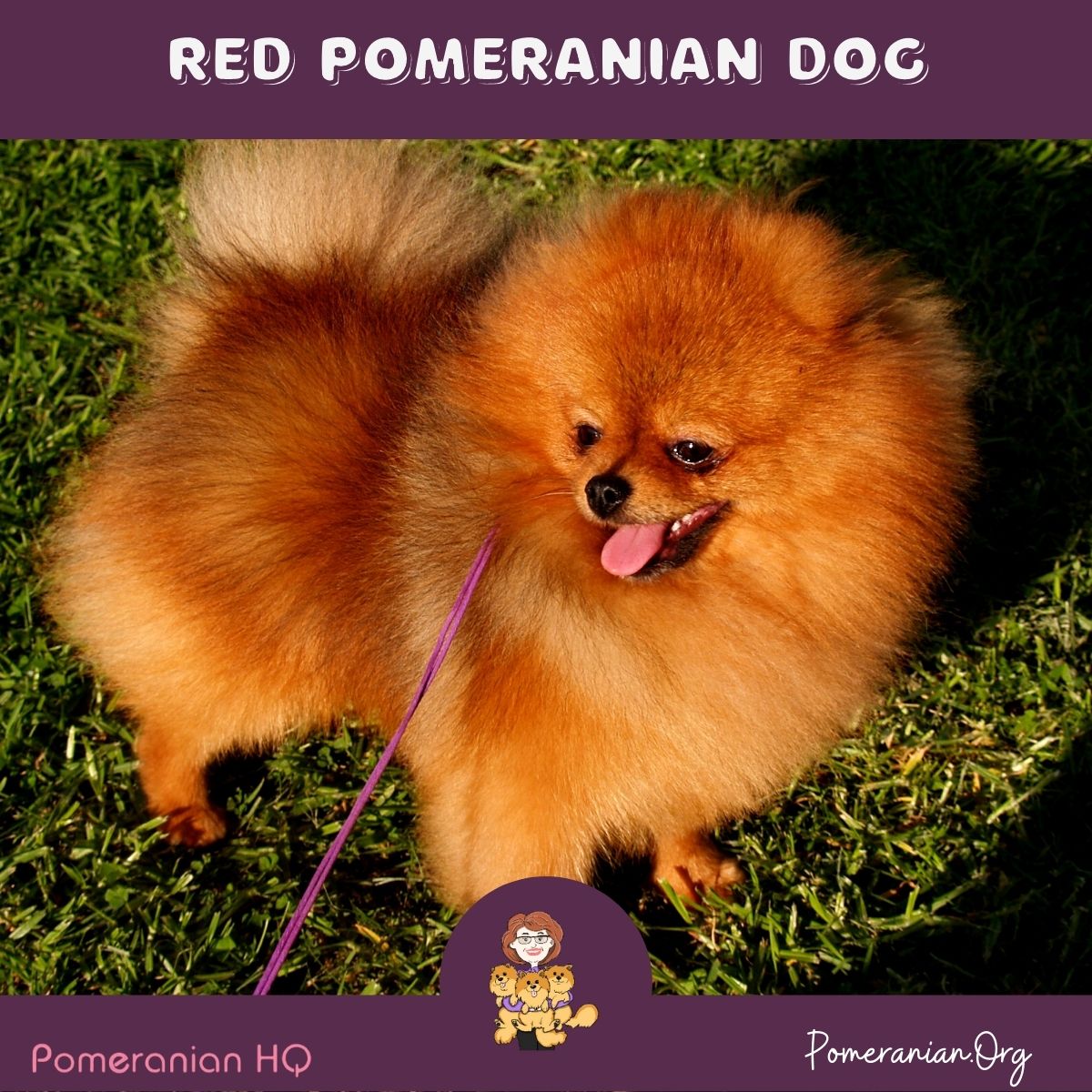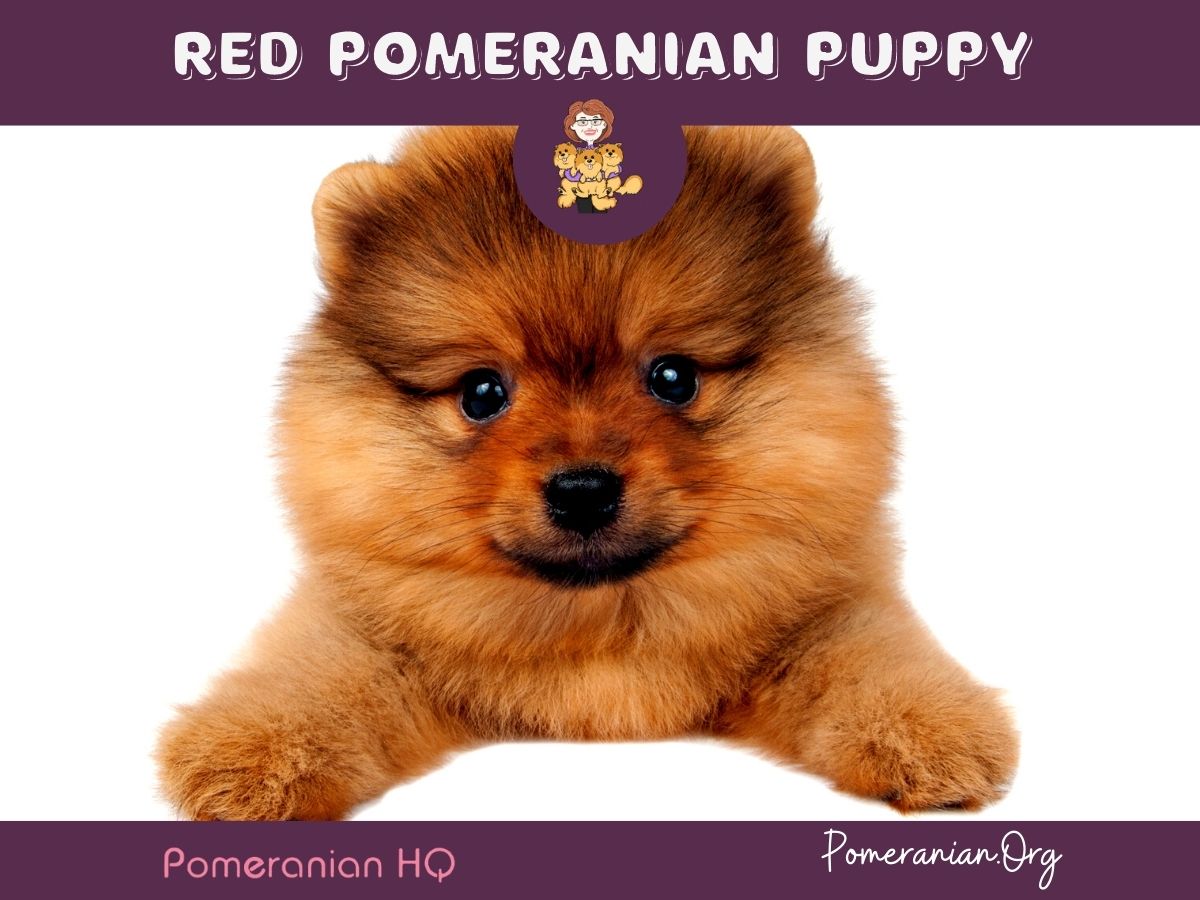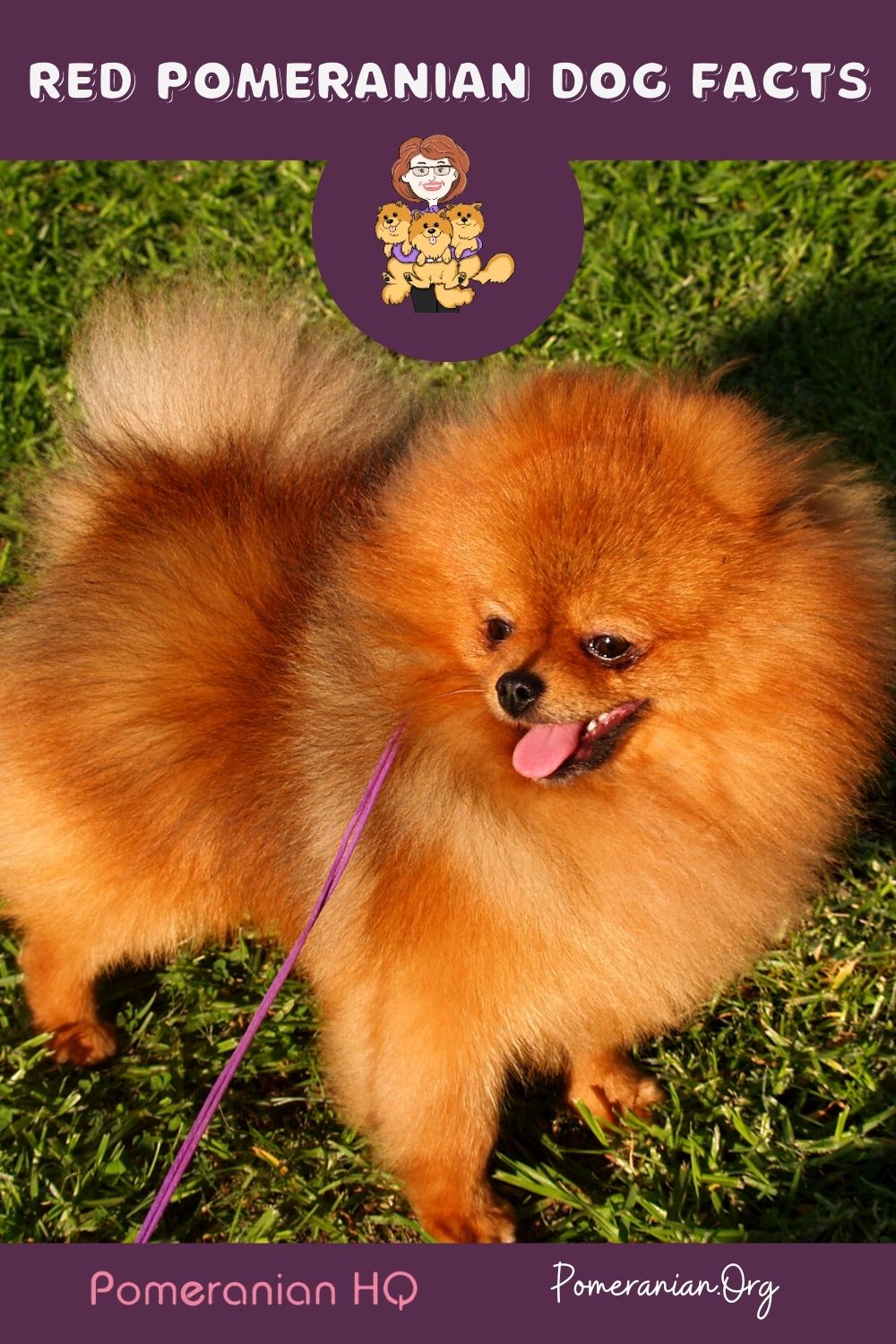Last Updated on 25/04/2024 by Dochlaggie. Post first published on May 26, 2022.
Thinking about adding a new furry member to your family and wondering what breed to choose? Are you looking for a glamourous, fiery red dog to welcome into your family? You’ve come to the right place to learn everything about these dogs.
Let’s take a quick overview of Red Pomeranian dogs and the genes responsible for red coloration on their thick double coat. As well as examining their temperament, grooming needs, and what types of lifestyles they best fit into.
Red Pomeranian Color Explained
The Red Pomeranian is a deep rust color almost appearing like a very dark orange. They are similar to orange Pomeranians but their color is a deep rich red. They will always have black points (nose, eyelids, lips, and paw pads).
A Red Pomeranian looks like a very dark orange. It can be very difficult to determine if a Pomeranian puppy will end up with a red, orange sable or orange coat during its puppyhood.
Red is a color that simply cannot be guaranteed in Pomeranians. An orange Pom may darken to red or a red may lighten.
A light-colored Pomeranian may transition over to red as he matures. It is very common for Red Poms to have been even a light orange puppy.

What Genes Cause The Red Coat in Red Pomeranian Dogs?
It seems incredible to know that all the different fur Pomeranian coat colors begin with only two color pigments. These pigments that determine a Pomeranian’s coat are eumelanin (black) and pheomelanin (red). All of the different coat colors are created by these two pigments.
Eumelanin gene has a default black color and codes for the black color spectrum. This codes color for the nose, eyes, and paw pad. Pheomelanin codes for the red color spectrum in Pomeranian’s adult coat.
Genes control the intensity of the color in Pomeranians making it stronger or diluted. Red Pomeranians don’t have the ability to produce dark pigment in their hair. Genes that contribute to a dog’s red coat color are:
A (agouti) locus: This locus is responsible for the amount of melanin that is released into the hair follicle as well as switching between the two base pigments of black and red.
E (extension) locus: This locus is responsible for creating the red coat without any black markings.
A clear light orange or red-colored Pomeranian can also be accomplished when breeding a clear red to a Pomeranian with sable, as long as the sable carries the recessive clear gene.
However, when clear red is bred to a sable Pomeranian, dark sable pups can also be produced from this type of mating.

Red Sable Pomeranian Dogs
Red sables have been a very popular color adult coat combination, dating back to Queen Victoria’s dog. A Red Sable Pomeranian is a Pom that has red fur with a sable pattern guard hairs. In a Red Sable Pomeranian, the base color of the coat is red with dark or black guard hairs.
The results of the sable gene can vary in appearance from a light sable to a very dark coat and pronounced sabling. Red Sable Pom puppies are usually very dark in color when they’re born and lighten up as they grow.
The Red Merle Pomeranian
Red Merle Pomeranians are red Pomeranians with a merle pattern. They’ll have a copy of the M merle gene on the M (merle) locus.
Double merles are often born all white and deaf. Due to possible health concerns, it’s best to only breed a merle Pomeranian to a dog that does not carry the merle gene to eliminate this possibility.
Will a Red Pomeranian Change Color?
The red shades in Pomeranians can lighten up over the years. The red shade can stay the way it was at birth and might also become lighter and darker again.
As a Pom puppy transitions from its puppy coat into its adult coat, it may darken and be a deep red dog or become lighter in color and end up being an orange dog.
Grooming Requirements of Red Pomeranians
You should groom your Red Pomeranian at least three times a week.
- The fluffy red hair requires frequent brushing to keep it clean and untangled.
- Pomeranians are very active little dogs, so you must keep their nails short.
- You’ll also need to brush your Red Pomeranian’s teeth every day.
- You should give a bath to your red Pomeranian once a month or so unless your dog gets muddy and needs an extra bath.
- After you give a bath to your furry pal, you’ll need to help dry them off.
- Cleaning around your dog’s eyes requires careful handling and a gentle touch.
- Regular ear examining and cleaning is also an important part of Red Pomeranian grooming to remove the buildup of wax and dirt.
If you neglect your Red Pomeranian grooming routine, your Pomeranian’s red coat may get matted, the fur may become brittle and the skin could dry out.

Personality And Temperament
All Pomeranians are known for being smart, confident, curious, energetic, feisty, and courageous dogs. They are very affectionate and loyal to their family. They are quick to sound an alarm if they find someone suspicious around the house. No matter what happens in your life, this amazing dog will remain by your side.
Like most Poms, Red Pomeranians are typically very playful and love to be the center of attention. They can make great pets for families but may not be the best choice for those who have small kids.
Red Pomeranians are considered intelligent and highly trainable. They have a good memory and need mental stimulation to stay away from destructive activities. If socialized properly in puppyhood, this breed makes a superb family dog.
What Health Problems are Red Pomeranians Prone To?
If you own or are planning to buy a Red Pomeranian, you need to be aware of his health concerns. Like all Poms, Red Pomeranians are typically very healthy and long-living dogs.
Let’s have a look into these health issues that may affect this breed:
- Hypoglycemia: It occurs when blood sugar levels suddenly drop. This can be very dangerous for Pomeranians, even sometimes fatal.
- Cataracts: It is one of the common problems affecting the Red Pomeranians. Cataracts can develop for a variety of reasons and appear at any age. Symptoms include a change in eye color, bumping into walls due to blurred vision, or swelling of the eyes.
- Luxating Patella: It is a common health issue in Red Pomeranians that affects the knee joint. This condition can occur due to a malformation of the bone or due to an injury when the kneecap slips out of place.
- Tracheal Collapse: It is a health issue with some Red Pomeranians. With small dog breeds like Pomeranians, the cartilage is more prone to injury. Symptoms of tracheal collapse include a unique honking noise, coughing, wheezing, or trouble breathing. While the condition can be related to genetics, it is preventable in some cases.
- Allergies: Red Pomeranians are prone to a variety of allergies. They may be allergic to pollen, dust, molds, certain foods, bedding, dog shampoos, and flea saliva.
It is important to get your Red Pomeranian to the vet as soon as possible if you see any problems. Buying from a responsible breeder will help ensure that you get a healthy dog.

What Is The Rarest Pomeranian Color?
Lavender Pomeranians are known to be among the rarest of all the Pom colors! Their unique coat results from breeding blue and beaver Pomeranians.
The result is a greyish coat with a pinkish, chocolate hue that almost appears light purple. Sometimes this lavender color is also called lilac. Lavender Pomeranians also have a lavender nose, lips, eye rims, and paw pads.
Final Thoughts
A Pomeranian’s coat can come in a variety of colors – from black to white to many colors in-between – including a stunning red. A Red Pomeranian is sure to catch people’s attention on your daily walks.
They will definitely turn out to be a perfect companion and shower the whole family with love and loyalty. The gene in Red Pomeranians doesn’t make it better or lesser than other beautiful colors out there.
If you are interested in buying a Red Pomeranian puppy, always get it from an ethical breeder. You will get a chance to meet the puppy’s parents, see their registered papers, and get a pure-bred and healthy Red Pomeranian.
There’s a lot more that goes into owning a dog than just coat color. Adopting a dog shouldn’t be done just on the basis of coat color. Remember that like small kids, our pets are heavily reliant on our care as owners!
You must give your Red Pomeranian high-quality food, take care of his exercise and grooming needs, and take him for check-ups to a vet.
Hope you enjoyed reading this article! Feel free to share your thoughts and questions. We would be happy to hear from you!
Happy POMMING!
Copyright Pomeranian.org. All Rights Reserved.
References and Further Reading:
[1] Official Standard of the Pomeranian (AKC). American Kennel Club, 2011.
[2] English Kennel Club Pomeranian Breed Standard, 2017.
[3] Denise Leo, The Pomeranian Handbook.
[4] Milo G. Denlinger “The Complete Pomeranian.”
[5] Kimbering Pomeranians “1891-1991”.
[6] William Taplin’s “The Sportsman’s Cabinet.”
[7] E. Parker “The Popular Pomeranian.”
[8] Lilla Ives “Show Pomeranians.”








